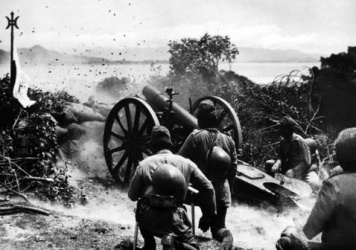Type 38 (150 mm)
Contents
Description
Write an introduction to the article in 2-3 small paragraphs. Briefly tell us about the history of the development and combat using the weaponry and also about its features. Make an air or ground vehicles list on which this weapon is installed in our game.
Vehicles equipped with this weapon
General info
Tell us about the tactical and technical characteristics of the cannon or machine gun.
Available shells
Describe the shells that are available for the cannon and their features and purpose. If it concerns autocannons or machine guns, write about different ammo belts and what is inside (which types of shells).
Comparison with analogues
Give a comparative description of cannons/machine guns, that have firepower equal to these type of weapons.
Usage in battles
Describe the cannon/machine gun in the game - its distinctive features, tactics of usage against the main opponents. Please don't write a "guide" - do not impose a single point of view, but give the reader food for thought.
Pros and cons
Summarize and briefly evaluate the weaponry in terms of its characteristics and combat effectiveness. Mark pros and cons as a list.
Pros:
Cons:
History
Imperial Japan, seeking out new artillery equipment, acquired 150 mm L/12 howitzers from Krupp in Germany in 1903. Starting by ordering a total of 36 from the manufacturer, Japan then acquired the license to manufacture the howitzers domestically. The resulting howitzer in Japanese service was called the 15 cm Type 38 field howitzer (for the 8th year of Emperor Meiji's reign (1905)).[1]
Essentially unchanged from the Krupp L/12 model, the gun retained rather modern features such as an open box trail and interrupted screw breech.[2] The weapon was rather lightweight at 2.09 tons.[3], due in part to a simple recoil mechanism needed for the small propelling charges for the shell. Consequently however, the 150 mm Type 38 suffered from a short effective range of less than 6,000 meters. This led to future procurements of howitzers such as the 150 mm Type 4 that had a higher effective range than the Type 38.
Though replaced from front-line service with newer howitzers by the 1930s, the Type 38 were still used until the end of World War II.[3] The guns were notably used in the Second Sino-Japanese war,[4] and as the main armament of the Ho-Ro self-propelled gun, assembled at the Osaka Arsenal.[5]
Media
An excellent addition to the article would be a video guide, as well as screenshots from the game and photos.
See also
Links to the articles on the War Thunder Wiki that you think will be useful for the reader, for example:
- reference to the article about the variant of the cannon/machine gun;
- references to approximate analogues by other nations and research trees.
External links
- References
- Bibliography
- Ness, Leland. Rikugun. Volume 2: Weapons of the Imperial Japanese Army & Navy Ground Forces. Helion and Company, 19 Dec. 2014.
- Taki "Type 38 15cm Howitzer" Imperial Japanese Army Page, Website. Accessed on 20 Apr 2021 (Archive).
- War Department Special Series No 25: Japanese Field Artillery United States Government Printing Offices, 15 Oct. 1944.
| Japan tank cannons | |
|---|---|
| 37 mm | Type 94 · Type 100 · Type 1 |
| 47 mm | Type 1 |
| 57 mm | Type 90 · Type 97 |
| 70 mm | Type 94 |
| 75 mm | Type 90 · Type 99 · Type 3 · Type 5 (Type I Model II · Type II Model I · Type II Model II) |
| 90 mm | Type 61 |
| 105 mm | Type 5 (Experimental · Production) · JSW L/52 |
| 106 mm | Type 60 (B) |
| 120 mm | Taishō Type 10 · Navy short gun · Type 90 L/44 · Type 10 L/44 |
| 150 mm | Type 38 |
| 155 mm | NSJ L/30 · JSW L/52 |
| Foreign: | |
| 25 mm | Oerlikon KBA B02 (Switzerland) |
| 35 mm | Oerlikon KDE (Switzerland) |
| 75 mm | M6 (USA) |
| 76 mm | M1 (USA) · M32 (USA) |
| 88 mm | KwK36 (Germany) |
| 90 mm | M3A1 (USA) · M36 (USA) |
| 105 mm | L7A3 (Germany) |
| 120 mm | Schneider-Canet 1898 (France) |




